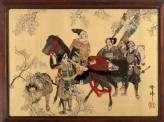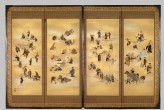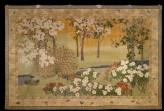Threads of Silk and Gold: Ornamental Textiles from Meiji Japan
(from 9th Nov 2012 until 27th Jan 2013)Discover exquisite embroideries, dyed silk and velvet panels, tapestries, and appliqué works
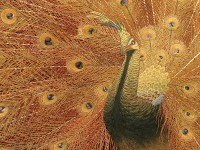
- This is a visual browsing tool that maps objects in this publication, gallery or collection trail by date of creation onto a timeline.
- The circular markers indicate where objects are on the timeline.
- The size of the markers indicates the relative number of objects at that point on the timeline.
- Hover over a marker to find out which objects are represented at that point in time.
- To expand, collapse or hide the timeline, click these symbols
 found at the top right of the timeline.
found at the top right of the timeline.
- 1850
- 1860
- 1870
- 1880
- 1890
- 1900
- 1910
- 1920
Embroidery
‘Their range of stitches, their ingenious methods and combinations, and the variety of effects attained with the needle and a few strands of coloured silk, easily place the Japanese first among all embroiderers...’
(Eliza Ruhamah Scidmore, Jinrikisha Days in Japan, 1891)
Of all the Japanese textiles arts, it was embroidery – the art of needlework – that most impressed foreign buyers during the Meiji period (1868-1912). Silk embroidery was first used for Buddhist textiles in the seventh century. It reached its peak of technical sophistication during the 1600s and 1700s, when it was used to decorate Nō costumes, kimono, obi sashes, and the gift wrappers known as fukusa. Embroiderers in the Meiji era continued to use traditional techniques and also developed new formats for the Western market: large-scale wall hangings, curtains, framed panels, and folding screens.
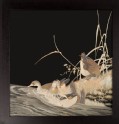 Ducks by a river bank (LI1956.2)
Ducks by a river bank (LI1956.2)
 Eurasian Jay (Garrulus glandarius) on a pine branch (LI1956.3)
Eurasian Jay (Garrulus glandarius) on a pine branch (LI1956.3)
 Nest of chicks in a lantern surrounded by doves (LI1956.12.1)
Nest of chicks in a lantern surrounded by doves (LI1956.12.1)
 Water birds and sparrows among lotus and iris plants (LI1956.12.2)
Water birds and sparrows among lotus and iris plants (LI1956.12.2)
 Greater spotted woodpecker in a forest by moonlight (LI1956.19)
Greater spotted woodpecker in a forest by moonlight (LI1956.19)
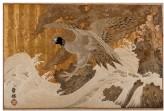 Sea eagle beneath a pine tree on a rocky seashore (LI1956.4)
Sea eagle beneath a pine tree on a rocky seashore (LI1956.4)
 Golden eagle on a snowy pine branch (LI1956.6)
Golden eagle on a snowy pine branch (LI1956.6)
 Hawk on a snowy pine branch (LI1956.20)
Hawk on a snowy pine branch (LI1956.20)
 Lion and lioness (LI1956.10)
Lion and lioness (LI1956.10)
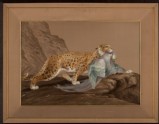 Ocelot carrying a dead macaw in a rocky landscape (LI1956.1)
Ocelot carrying a dead macaw in a rocky landscape (LI1956.1)
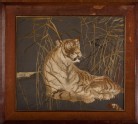 Tiger among reeds (LI1956.13)
Tiger among reeds (LI1956.13)
 Head of a tiger (LI1956.14)
Head of a tiger (LI1956.14)
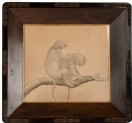 Pair of macaque monkeys on a branch, one grooming the other (LI1956.9)
Pair of macaque monkeys on a branch, one grooming the other (LI1956.9)
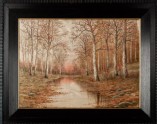 Trees beside a stream in autumn (LI1956.18)
Trees beside a stream in autumn (LI1956.18)
 Stormy sea with seagulls (LI1956.8)
Stormy sea with seagulls (LI1956.8)
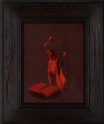 Young woman reading a book illuminated by orange light (LI1956.17)
Young woman reading a book illuminated by orange light (LI1956.17)
 Skeleton kneeling playing a shamisen, or plucked instrument (LI1956.16.1)
Skeleton kneeling playing a shamisen, or plucked instrument (LI1956.16.1)
 Skeleton dancing with a fan (LI1956.16.2)
Skeleton dancing with a fan (LI1956.16.2)
Oshi-e
‘Pictures are made by pasting pieces of silk, etc., cut out in such a way, as to represent personages in full dress, insects of flowers on a sheet of paper, etc. Occasionally, these pictures display a great deal of humorous ingenuity.’
(International Exhibition, Philadelphia 1876: Official Catalogue of the Japanese Section)
One type of ornamental textile that became popular in the West in the early Meiji era was oshi-e, a technique in which fabric is pasted over paper or silk wadding to create padded relief designs. The technique probably dates back to the 1400s. It is believed that this craft began among the women of Kyoto’s aristocratic classes and gradually spread to the wider population. Different types of fabric, often recycled kimono silks, were used to create different effects. Details such as facial features were then hand-painted on. The oshi-e technique was often used on wooden plaques donated to shrines and temples with prayers for good fortune, or to decorate hagoita, the wooden bats used in New Year’s games.
Yuzen-dyeing
‘Dyeing is ... an art that is brought to a high degree of perfection in Japan. Sometimes an elaborate design ... looks almost like a water- colour, so closely do the colours mingle one with another.’
(Mortimer Menpes, Japan: A Record in Colour, 1901)
Dyeing techniques using rice-paste resist with stencils became a popular method of patterning fabrics in Japan in the 16th century. Around 1700, the sophisticated yūzen silk-dyeing technique was developed, in which the paste was applied free-hand onto the silk through a funnel, and the dye applied with a brush. This allowed the creation of more pictorial designs. The introduction of chemical dyes and pre-coloured paste in the Meiji era simplified the complicated dyeing process and made it possible to create complex designs more quickly and cheaply.
Around 1880, the Kyoto textile producer Nishimura Sōzaemon applied his knowledge of yūzen dyeing techniques to velvet (yūzen birōdo).
 Screen depicting scenes from spring and summer (LI1982.2.1)
Screen depicting scenes from spring and summer (LI1982.2.1)
 Screen depicting scenes from autumn and winter (LI1982.2.2)
Screen depicting scenes from autumn and winter (LI1982.2.2)
 Group of cockerels among grasses (LI1956.5)
Group of cockerels among grasses (LI1956.5)
 Leaping carp (EA1997.224)
Leaping carp (EA1997.224)
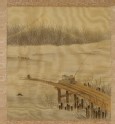 Fisherman on a pier (EA1997.225)
Fisherman on a pier (EA1997.225)
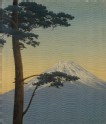 Pine tree and Mount Fuji (EA1958.115)
Pine tree and Mount Fuji (EA1958.115)
Tapestry-weaving
‘To such masterly perfection has this art been carried that any picture can be reproduced in weaving, especially in that kind of weaving for which Kyoto artisans are celebrated, namely, the tsuzuri-ori, in which all the chiaroscuro, all the delicacy of touch or boldness of stroke of the original picture, are faithfully reproduced at will with threads...
(Count Shigenobu Okuma, Fifty Years of New Japan, 1909)
Weaving was the oldest technique used to create patterned textiles for the elite in Japan, with Kyoto at the centre of production. Particularly admired abroad during the Meiji era (1868-1912) were nishiki silk ‘brocades’. One type of nishiki was tsuzure-ori or tapestry weave. This was a laborious, time-consuming process, with some of the more elaborate pieces made by top producers like Kawashima Jinbei in Kyoto taking as long as five or six years to make. The Meiji period saw great changes in the weaving industry with the introduction of mechanised looms and loom attachments from Europe.
Notice
Objects from past exhibitions may have now returned to our stores or a lender. Click into an individual object record to confirm whether or not an object is currently on display. Our object location data is usually updated on a monthly basis, so please contact the Jameel Study Centre if you are planning to visit the museum to see a particular Eastern Art object.
© 2013 University of Oxford - Ashmolean Museum

